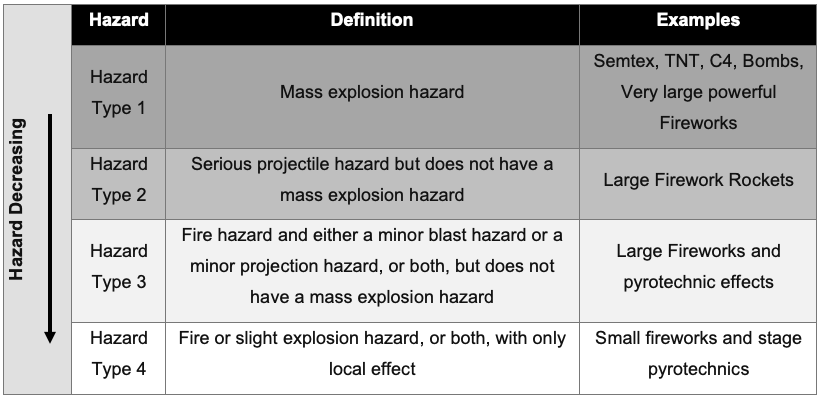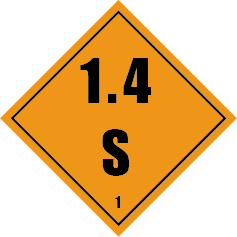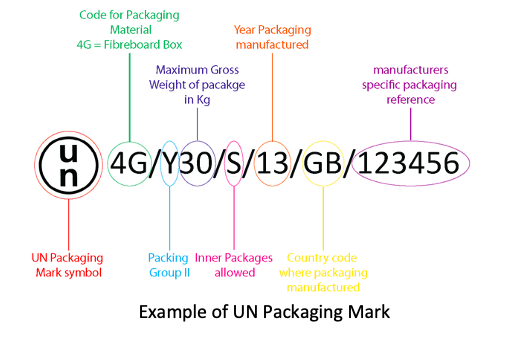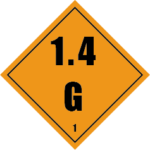Dangerous Goods General Information
Dangerous Goods come in many forms, obvious ones like radioactive materials, ammunition, corrosive acids, flammable gasses and explosives, but also not so obvious ones like batteries, CO2 bulbs, aerosols, and onion essence. Smokes, Pyrotechnics and fireworks form part of the explosives group, so if a product is a smoke or a pyrotechnic, it is considered an explosive regardless of the type of pyrotechnic it is or the effect it produces e.g. smoke, fireball, flame, sparks or crater forming bangs.
When it comes to transporting dangerous goods there is a heap of regulations designed to protect the dangerous goods during transport, to prevent spillage/accidents, to protect and warn those transporting the dangerous goods, as well as the general public.
Each type of Dangerous Goods is represented by a coloured diamond which you may have noticed on vehicles and packages, these warn of the nature of the Dangerous goods contents within the vehicle / package.

Class 1 Explosives are represented by an orange diamond.
Classification of Explosives
As you may guess, explosives come in many different types from high explosives, missiles, ammunition, fireworks, pyrotechnics, car airbags, hail rockets etc. all of which have different properties and will have different effects when they go off, accidentally or on purpose.
Every explosive and explosive article, regardless of the manufacturer, that is sold in the UK, MUST be granted a classification by the HSE Explosives Inspectorate.
The classification of explosives is the determination of the hazard that the explosives present when packaged for transport. The classification process is a series of tests on the packaged explosives to determine how safe they are to transport. Therefore, the style of packaging and the quantity packed is just as important as the product itself when classifying explosives. The combined results of the tests determine the Hazard Class of the explosive, those being:

Once the Hazard Type has been established from the tests (EG products are Hazard Type 4), depending on the type of product e.g. Smoke, pyrotechnic, firework ammunition etc, the Article or material will be given a UN number (United Nations identification number), a Proper Shipping Name (P.S.N), Hazard Class, and category and associated orange diamond.
Example – Wire Pull Smoke
UN Number = UN0507
Proper Shipping Name = SIGNALS, SMOKE
Hazard Class and Category = 1.4S
Hazard Diamond = 
Packaging
The results of the tests performed on the packaged products are dependent on the several factors, for example the number of products, how tightly they are packed in a box and the type of packaging. If these elements change then the hazard class and category could also change i.e. packing 10 fireworks in a cardboard box will give different results than 100 fireworks of the same type packed into a metal or wooden case.
Therefore, all explosives must always be packaged in the same way as when they were tested and according to the information on the classification certificate issued by the HSE Explosives section.
Because the classification of an explosive is packaging dependant, the packaging is required to be tested and specified. Each type of packaging that can carry dangerous good is stamped with a UN packaging mark. For explosives, the packaging used e.g. cardboard box, must have the same UN packaging mark as that specified on the classification certificate issued by HSE, this ensures the packaging is the same as the packaging used in the classification tests.

So that anyone handling a package of dangerous goods know the hazards, the package must be marked and labelled with the following information:
Packaging EG Pyrotechnics
The method and type of packaging does very, depending on the manufacturer but there will be similarities e.g. packaged in a fibreboard outer carton.
EG products should be packaged in an inner box and then those inner boxes(es) into a UN approved outer fibreboard carton with the first parts of the packaging mark showing the following:

The UN packaging mark must be printed directly onto the outer carton.
The maximum quantity of products allowed in the inner box(es) and outer carton(s) is shown for all products in the table at the end.
Marking & Labelling
So that everyone in the supply chain and the emergency services in the unfortunate event of an accident, understand the hazards posed by the packages containing Dangerous Goods, they must me marked and labelled with the following information.
- UN Number – Internationally recognised number describing the type of Dangerous Goods
- Proper Shipping Name (P.S.N) – Standardised name for the type of Dangerous Goods
- Gross Weight – Total weight of package
- Net Content – Actual weight of the dangerous goods without packaging.
- Hazard Diamond – The applicable hazard diamond which identifies the dangerous goods.
- Consignee – Name and address of the person receiving the Dangerous Goods.
- Consignor – Name and address of the person sending the Dangerous Goods.
- Handling Labels – specific labels giving handling instructions e.g. this way up, keep dry, keep out of sun etc.
For Explosives Only
- Net Explosive Content (NEC) – This is the total weight of the explosive material contained within all the products in the package.
Two examples are shown below using two different styles, but in each case all the necessary information is shown.


Packaging Summary
- Pack the products into inner boxes ensuring the products do not move around.
- Pack the inner boxes into a UN approved outer carton.
- Make sure that the number and type of products packed are correct for the size of outer carton.
- Seal the outer carton.
- Mark and label the boxes correctly.
Shipping info for 3rd Light pyrotechnics
| Product | UN no. | Proper Shipping Name | Hazard Class | Hazard Diamond | NEC (Device) | NEC (Outer Carton) | Quantities (Inner Box) | Quantities (Outer Carton) |
|---|---|---|---|---|---|---|---|---|
| EG25 Micro Smoke | 0507 | SIGNALS, SMOKE | 1.4S |  | 15g | 3 Kg | 20 | 200 |
| Wire Pull® Smoke | 0507 | SIGNALS, SMOKE | 1.4S |  | 50g | 5 Kg | 50 | 100 |
| Burst Wire Pull® Smoke | 0507 | SIGNALS, SMOKE | 1.4S |  | 40g | 4 Kg | 50 | 100 |
| EG18 Assault Smoke | 0507 | SIGNALS, SMOKE | 1.4S |  | 100g | 2.5 Kg | 12 / 13 | 25 |
| EG18X Cover Smoke | 0507 | SIGNALS, SMOKE | 1.4S |  | 140g | 3.5 Kg | 12 / 13 | 25 |
| EG18 Assault Smoke | 0197 | SIGNALS, SMOKE | 1.4G |  | 100g | 5 Kg | 25 | 50 |
| Mil-X / PSG | 0431 | ARTICLES PYROTECHNIC, for technical purposes | 1.4G |  | 130g | 6.5 Kg | 25 | 50 |
| SD75 High Output Smoke | 0431 | ARTICLES PYROTECHNIC, for technical purposes | 1.4G |  | 140g | 5.0 Kg | 1 | 12 |
| CM75 High Output Smoke | 0431 | ARTICLES PYROTECHNIC, for technical purposes | 1.4G |  | 140g | 4.5 Kg | 1 | 12 |
| EG67 Ball Grenade | 0432 | ARTICLES PYROTECHNIC, for technical purposes | 1.4S |  | 0.5g | 0.025 Kg | 25 | 50 |
| Wire Pull® Paint Grenade | 0432 | ARTICLES PYROTECHNIC, for technical purposes | 1.4S |  | 0.5g | 0.025 Kg | 25 | 50 |
| Wire Pull® Flash 1.0 | 0431 | ARTICLES PYROTECHNIC, for technical purposes | 1.4G |  | 1.5g | 0.15 Kg | 50 | 100 |
| Wire Pull® Flash Grenade 3.0 | 0431 | ARTICLES PYROTECHNIC, for technical purposes | 1.4G |  | 3.0g | 3.0 Kg | 50 | 100 |
| Mk5 Thunderflash | 0431 | ARTICLES PYROTECHNIC, for technical purposes | 1.4G |  | 0.5g | 0.1 Kg | 100 | 200 |
| Mk7 Thunderflash | 0431 | ARTICLES PYROTECHNIC, for technical purposes | 1.4G |  | 3g | 0.42 Kg | 60 | 120 |
